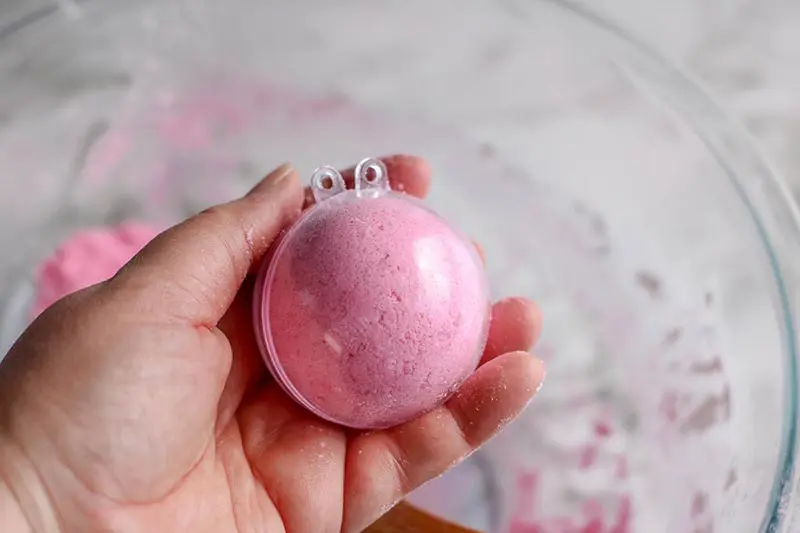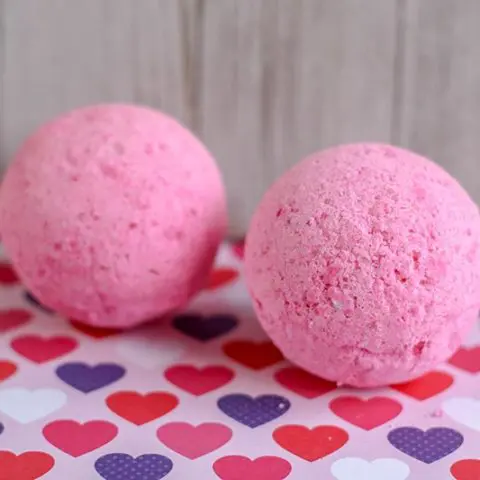Make these homemade fizzy bath bombs for a fun Valentines STEM activity for kids. This is an easy DIY bath bomb recipe kids can make and is a perfect fizzing science experiment.
We love encouraging kids to participate in STEM activities (science, technology, engineering, math) and it’s especially important for girls.
This is a great activity to do at home and could also be done in an elementary school classroom as well.
Older children can assist with creating these pink fizzing bath bombs. Preschoolers, kindergartners, and kids of all ages can help conduct and observe the experiments.
For another Valentine’s Day STEM activity, check out our DIY Valentine Glitter Slime.
We have a couple more great fizzing science experiments: melting rainbows and fizzy bottle caps. Also, don’t miss this list of 30 science activities for kids!

This post contains affiliate links. As an Amazon Associate and a participant in other affiliate programs, we earn a commission on qualifying purchases.
Pink Fizzing Bath Bombs Valentine’s Day Science Experiment
Making homemade bath bombs is a great hands on learning activity for kids and also makes a fun science fair project.
Students will practice measurements and how to follow a recipe as they create the bath bombs.
After making them, you can discuss the chemistry that takes place as the bath bomb dissolves in water.
Children will be able to see the chemical reaction caused by the baking soda and citric acid when placed in water.
This reaction creates carbon dioxide gas which is what causes the fizzy bubbles in the water.
Kids love watching it fizz and turn the water pink!
The temperature of the water and the bath bomb ingredients affect how fast and how much it fizzes.
Try placing a bath bomb in cold water, warm water, and hot water. Have the children make a hypothesis and then observe and record the results.
Another fun way to experiment is by changing the ingredients and comparing the results.
For example, make some bath bombs with citric acid and others with a citric acid substitute, such as cream of tartar or lemon juice. There are a few ingredient substitution options included below.

Easy Homemade Fizzing Bath Bomb Recipe
Baking soda, cornstarch, and citric acid are key ingredients in this bath bomb recipe.
You may not have citric acid in your cupboard, but it is easy to order from Amazon. It’s often used in bath bombs, food products, and natural cleaning solutions.
If you do not want to use citric acid, you can substitute cream of tartar for half the amount. You may need to tweak the ingredient ratios a bit. They generally will fizz less if made without citric acid.
In this recipe, we use mica powder to make colored bath bombs. Pink, red, and purple are all great color choices for Valentine’s Day themed bath bombs!
You could also use a few drops of food coloring instead of mica powder, especially if making these for a hands on science activity rather than for a bath. Just add the food coloring in with the wet ingredients.
The coconut oil helps with blending in essential oils for fragrance, but you can use olive oil or vegetable oil. The essential oils are a nice touch for scenting the bathwater, but you can skip those if you wish.
Pink Fizzy Bath Bomb Ingredients
- 1 cup baking soda
- ½ cup cornstarch
- ½ cup citric acid (or ¼ cup cream of tartar)
- ½ cup Epsom salt
- 1 teaspoon Pink Mica powdered soap dye
- 10 drops essential oils of your choice (optional)
- 2 ½ tablespoons coconut oil, melted (or any oil)
- 1 tablespoon water
- 8 to 10 bath bomb molds
How to Make Pink Fizzy Bath Bombs for Kids
In a large bowl, whisk together the dry ingredients: cornstarch, citric acid, Epsom salt, baking soda, and mica powder.
If you want to make more than one color, divide the dry mixture into separate bowls before adding the mica powder. Adjust the amount as needed.
In a small measuring cup, whisk together essential oil, coconut oil, and water. If you are making more than one color in this batch, you will also need to divide this mixture into separate bowls.
Very slowly (try to avoid as much fizzing as possible) add the water and oil solution to the dry ingredients.

Stir and mash everything together until it resembles sand.

Then immediately transfer the bath bomb mixture into the bath bomb molds.
Press mixture tightly into each side and add a little to overflow each side of the mold. Then press the mold together, twisting until closed.

Let the bath bombs dry for at least 24 hours.
To remove the bath bombs from the molds, tap the outside of the mold gently. Then twist each side of the mold and pull to remove the bath bomb.

Now they are ready to use in your science activity, for bath time, or to give as a gift. Wrap them tightly in plastic wrap or place in an airtight container until ready to use. The sooner they are used, the better they will fizz!
More Science Activities for Kids:
- Balloon Air Pressure Experiment
- Rainbow Candy Experiment
- Oil and Water Color Changing Lab
- Unicorn Density Tower
- Ocean Zones Density Tower
- Is Slime a Liquid or Solid?
- Human Body BINGO Game
- Melting Rainbows Preschool Experiment
- Fizzing Bottle Caps Experiment
- Galaxy Oobleck
- Butterfly Life Cycle Worksheet
More Valentines Activities:
- Homemade Valentine Slime Recipe
- Home is Where the Heart Is Popsicle Stick Craft
- Heart Transfer Card
- Cute Zoo Animal Valentine Printable Cards
- Shopkins Printable Valentines
- Shopkins Lollipop Covers
- Stained Glass Valentines Cookies
- Valentine’s Day Crafts for Toddlers

Fizzy Pink Bath Bombs
Make these homemade fizzy bath bombs for a fun Valentines STEM activity for kids. This is an easy DIY bath bomb recipe for kids to make and is the perfect fizzing Valentines science experiment.
Materials
- 1 cup baking soda
- ½ cup cornstarch
- ½ cup citric acid (or ¼ cup cream of tartar)
- ½ cup Epsom salt
- 1 teaspoon Pink Mica powdered soap dye
- 10 drops essential oil (optional)
- 2 ½ tablespoons coconut oil, melted (or any oil)
- 1 tablespoon water
Tools
- 8 to 10 bath bomb molds
Instructions
- In a large bowl, whisk together the dry ingredients: cornstarch, citric acid, epsom salt, baking soda, and mica powder.
- In a small measuring cup, whisk together essential oil, coconut oil, and water.
- Very slowly (try to avoid as much fizzing as possible) add the water and oil solution to the dry ingredients.
- Stir and mash everything together until it resembles sand.
- Then immediately transfer the bath bomb mixture into the bath bomb molds.
- Press mixture tightly into each side and add a little to overflow each side of the mold. Then press the mold together, twisting until closed.
- Let the bath bombs dry for at least 24 hours.
- To remove the bath bombs from the molds, tap the outside of the mold gently. Then twist each side of the mold and pull to remove the bath bomb.
- Now they are ready to use in your science activity, for bath time, or to give as a gift. Wrap them tightly in plastic wrap or place in an airtight container until ready to use. The sooner they are used, the better they will fizz!
Students will practice measurements and how to follow a recipe as they create the bath bombs.
After making them, you can discuss the chemistry that takes place as the bath bomb dissolves in water.
The temperature of the water and the bath bomb ingredients affect how fast and how much it fizzes.
Try placing a bath bomb in cold water, warm water, and hot water. Have the children make a hypothesis and then observe and record the results.
Another fun way to experiment is by changing the ingredients and comparing the results. For example, make some bath bombs with citric acid and others with a citric acid substitute, such as cream of tartar or lemon juice.
Notes
If you do not want to use citric acid, you can substitute cream of tartar for half the amount.
You can use food coloring instead of mica powder. Just add the food coloring in with the wet ingredients.
You can use any oil in place of coconut oil.
Essential oils are for adding natural fragrance and are optional.
Drying time is approximate.


Darcy is the founder of “Life With Darcy and Brian,” where she combines her love for education, board games, and crafting to create engaging learning experiences for kids. Her creative projects and writing have been featured in outlets like The Toy Insider, CafeMom, Mom.com, Parents.com, Country Living, and The Pioneer Woman.

